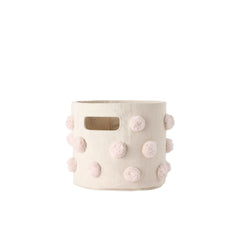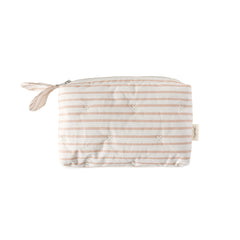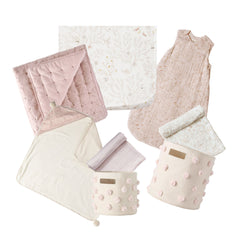Tummy time is an important component of your baby’s development. From preventing flat spots on your little one’s head to promoting healthy growth, tummy time has a variety of benefits. In this article, we’ll walk you through what tummy time is, why it’s so important, and how to do it safely and effectively.
Table of Contents
- What is tummy time?
- Why do I need to do it?
- When should I start?
- How often should I do tummy time?
- What positions can I try?
- What should I have on hand?
- When should I stop?
What is tummy time?
If you’ve ever spent time around a new mom you’ve probably heard the term repeated often. But, if you’re not exactly sure what tummy time is, don’t worry - you’re certainly not alone. Tummy time is a mystery to many first-time parents and we’re here to shed some light on the topic to help you prepare for the arrival of your newborn. Let’s begin with the basics: what is tummy time? It is an important exercise your little one should partake in to assist with healthy development. As the name suggests, tummy time is when your baby is placed on their stomach while they are awake and supervised.
Why do I need to do it?
This is an incredibly important activity for a number of different reasons.
- It helps to prevent something known as positional plagiocephaly. This is when skull bone plates settle in a way that creates flat spots on a newborn’s head as a result of being in the same position for long periods of time.
- It also helps to prevent a condition known as twisted neck or positional torticollis. This is when a baby’s neck muscles become tight causing the baby to tilt their head to one side.
- It isn’t just about preventing conditions like positional plagiocephaly and positional torticollis. It’s also helpful for promoting healthy growth and development in your baby. Tummy time gives your little one the opportunity to develop their neck, back, and shoulder muscles.
- It will also help your baby meet key developmental milestones like pushing up on their arms, lifting their head, rolling over, and, eventually, crawling.

When should I start?
There’s no question that tummy time is an important activity for your newborn. But when should they start? Believe it or not, you can start newborn tummy time as soon as you bring your baby home from the hospital. Many parents are understandably nervous about putting their newborns on their stomachs as we read and hear about the risk of sudden infant death syndrome (SIDS) so often. However, as long as your baby remains supervised the entire time, it is perfectly safe for newborns. Infants can have 2 - 3 sessions that last about 3 - 5 minutes each every day.
How often should I do tummy time?
As your baby grows you can increase the number of sessions you do each day as well as their length. It is recommended that you work your little one up to about an hour of tummy time a day by the time they are three months old.
As your baby grows and gets stronger you might also want to start incorporating play and other exercises as well. You can do this by placing toys slightly out of your baby’s reach to get them to practice reaching for objects. You can also place different tummy time toys all around the baby in a circle. This way they will practice reaching in different directions and engage more muscles. In time, they may begin rolling over or crawling towards their toys. Keeping them close by in a storage basket makes getting them out easy!
What positions can I try?
Many new parents think that there is only one tummy time position but, in fact, there are a few ways you can position your little one that can count towards your daily quota. These positions will all help prevent conditions like positional plagiocephaly and positional torticollis while promoting the healthy development of your baby’s postural muscles. Here are just a few options you can explore:
- Tummy-to-tummy or tummy-to-chest: Instead of putting your little one on the floor or bed, try lying down with them and placing your baby on your stomach or chest so you are face-to-face. Make sure both you and your baby are secure to avoid any accidents.
- Tummy down carry: Also known as the football hold, the tummy down carry is another great way to get some newborn tummy time in. Position your hand on your baby’s stomach and drape their legs over either side of your arm. Your other hand can be used to support the baby’s head and neck. Be sure to hold your baby close to your body while they are getting used to this new position as it will help them feel more safe and secure.
- Lap soothe: A fairly straightforward position, for the lap soothe, you’ll simply drape your baby over your lap and place one hand on your baby’s bottom to ensure they feel comfortable and secure. This position is a great option because it can be used to burp your little one as well.
What should I have on hand?
The first thing you’ll want on hand for tummy time is a comfortable blanket or play mat. Our play mats are quilted to give your baby a little bit of extra cushioning. Interesting patterns and textures can also keep your little one engaged and entertained. If you’re doing a session on a surface that is already nice and soft, a swaddle blanket is a great option to lay down over your bed or couch. It’s also a good idea to have some toys on hand. As we discussed earlier, you can use these to distract and soothe your little one, as well as encourage them to engage different muscles as they reach for their favorite play items. You might also want to have a tummy time pillow on hand. This is a crescent-shaped pillow that can provide support as your baby begins to engage their neck, back, and shoulder muscles. Regular pillows are great to have on hand as well. You can line these up around your tummy time area to keep your baby safe and contained. Finally, it’s great to have some storage baskets nearby because tummy time will come and go several times a day. Having a nearby storage pint or basket will help you keep your living area organized while also ensuring all of your essentials are handy for your next session. A nursing pillow is also a great option to try for babies who need a bit more support for tummy time or don’t like being directly on a flat surface. You can prop up your little one with their arms and torso over the nursing pillow for additional support.
When should I stop?
A lot of parents wonder when to start tummy time, but, how do you know when to stop? Your child regularly moving through different positions by rolling over during tummy time is a great indication that you can stop setting aside dedicated time for this activity. This typically happens between the five to seven-month range, although every child is different. Just because your child has begun rolling over and no longer needs it doesn’t mean that your little one will stop spending time on their tummy, it just means that they will start to do so in new and more independent ways. Typically, they’ll begin to crawl on their stomachs and then on their hands and knees.








